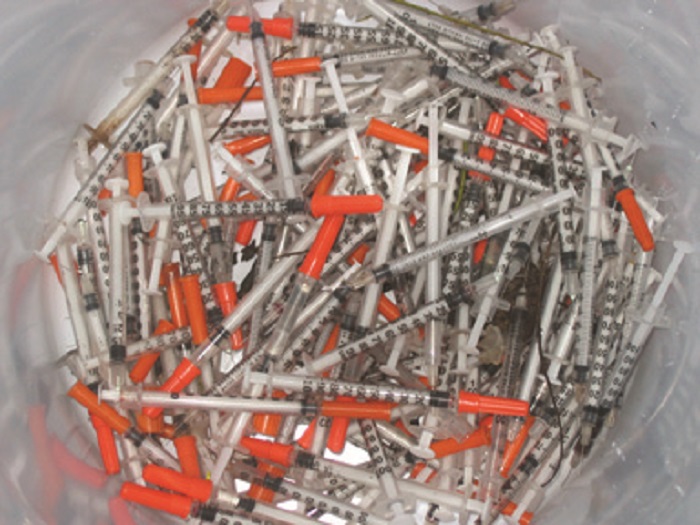Deer have become a common nuisance throughout suburban and rural Maryland, eating flowers and plants, and presenting danger on the roadways. An ongoing study by researchers in Pennsylvania, with which Maryland shares a 233-mile border, supplies some interesting answers about deer behavior.
By Ad Crable
Bay Journal
Who knew that deer salivate about 2 gallons a day or that a fawn has 272–342 spots on its coat?
Or that a doe may choose to give birth to fawns near a road so that fewer bears, coyotes and bobcats are around? Or that a deer may consume more than 100 different plant species a year?
After a decade of following and studying 1,200 live-trapped deer, fitting them with ear tags and GPS radio collars to track their movements, Pennsylvania researchers are getting an unprecedented look into the behavior of one of North America’s most widespread mammals and their imprint on the landscape.

In 2013, the sweeping Deer-Forest Study was launched and funded by the Pennsylvania Game Commission, Pennsylvania Bureau of Forestry, U.S. Geological Survey and Penn State — each with an interest in what happens between deer, soil and plants in 2.2 million acres of state forests, 1.5 million acres of state game lands and millions more acres of private land across the state.
The study, which won’t be wrapped up until 2026, could shape how land managers ensure healthy forests in an age of climate change and invasive plants.
It offers new nuances to be considered by game managers in determining how many deer are being killed by hunters because hunting is the primary means for controlling deer populations. And it helps the Game Commission with the difficult decision about how many deer should be culled each year for the herd to remain in balance with available habitat.
“This study is unique,” said Duane Diefenbach, leader of Penn State’s Pennsylvania Cooperative Fish and Wildlife Research Unit. “Looking at all these different factors at the scale we are looking at, and the interaction over a long time, is really a first.”
One aim of the year-round study is to learn how vegetation responds to changes in deer densities and various tweaking to forests by managers. It’s commonly known that unchecked deer can browse the forest floor so heavily that trees and desirable plants never get a chance to regenerate. But the study is showing that what happens in a forest and the best ways to ensure its future growth is much more complex and involves a dance of wildlife, plants and soil.
In some cases, deer may be overly blamed for problems in the understory. A team of about 20 people scrutinized approximately 170 species of herbs, shrubs and trees on 200 fenced and unfenced plots in three state forests with a mix of unfragmented forests, and other plots with a mix of forest and farmland.
They found that the absence of a native plant does not always indicate over-browsing by deer. For example, the researchers found that Indian cucumber-root, an important native species and delicacy for deer, did not grow in areas where the soil was acidic and high in manganese.
This is important because the state Department of Conservation and Natural Resources uses a browsing index to determine how many deer can sustainably live in a section of forest and how many need to be removed by hunters. Indian cucumber-root is one of the species monitored and, at least in some cases, its disappearance may be blamed falsely on deer.
In a related finding, researchers found that field technicians had trouble consistently scoring how deer browsing affects understory vegetation. That subjective measurement is part of the deer impact index used by state forest managers. Generally, plants that deer like to browse are sampled for abundance and regrowth. The study is investigating if there is a more reliable way to accurately determine the effect of deer on vegetation.
The study is also highlighting the importance of sunlight filtering through treetops to understory vegetation. Again, deer may be excessively blamed for lack of regrowth in the forest.
Still, Diefenbach cautioned, “that doesn’t mean we can have more deer. A healthy deer population relies on a healthy forest.”
In addition to impacts from deer, forest plots are showing that controlled burns help to regenerate trees and many plants. Also, tree-cutting and herbicide treatments for invasive plants help a forest maintain itself. One preliminary finding is that spraying invasive nonnative plants does indeed help tree seedlings rebound.
Deer insights
Discussions of soil and forest interactions aside, the most interest shown in the study by far has been from wildlife lovers and deer hunters who are gaining new and surprising insights into the behavior of white-tailed deer.
To gain an intimate look into the lives and times of deer, researchers have live-captured more than 1,000, from fawns to geriatric bucks, in four areas of the state.
Attracted by a bait of shelled corn, deer are lured into cages or netted in 60-by-40 foot traps triggered by a nearby technician.
Most captured deer are fitted with GPS radio collars so their movements can be tracked remotely around the clock. Researchers analyze DNA in deer pellets to track those that were captured but not fitted with radio collars.
GPS collars have enabled researchers to plot deer locations more than 1 million times over the last 10 years. Their movements are related in the conversational field diaries that researchers share online.
The often-humorous dispatches have attracted more than 2 million views as they shed light on deer behavior.
One female was captured in 2003 as a fawn.
While many deer are shot by hunters — most bucks will not survive to age 3 — the doe was recovered in 2015 after being killed at nearly 14 years of age during muzzleloader deer season.
Some females have small transmitters placed in their birth canals. When they give birth, the device is expelled and activated, revealing the newborn’s location. Technicians rush to the birthing bed to capture the immobile fawn nearby.
The fawn’s collar communicates with the doe’s collar, enabling researchers to study doe-fawn interactions, learn which kind of terrain a doe selects to have her fawns and assess fawn survival rates.

It turns out that mother does are pretty hands-off. They only approach their fawns two or three times a day to nurse and hang around about 300 feet away. The rest of the time, the fawns are lying camouflaged on the forest floor.
Too often, this leads some people to conclude the fawn has been abandoned. Not so. And if you approach the fawn and leave your scent, it may attract predators. Also, it takes several days for fawns to imprint on their mothers. Until then, a fawn may imprint on almost any moving thing, including humans.
There also have been surprises to conventional assumptions long held by hunters.
For example, hunters generally believe that deer are most active first thing in the morning, and therefore they head out well before dawn, assuming few deer are moving at lunchtime.
But deer movements tracked in the study showed that most spent the early hours bedded down, finally beginning to wander around at about 10 a.m. The peak movement for bucks took place 12–1 p.m. They rested in the afternoon before moving again from 4 p.m. to dusk.
“How often is life fair? Umm, never. So, rifle hunters rejoice. You too can spend an extra hour or two in that nice, cozy, warm bed,” confided one of the study’s bloggers.
The study is providing answers on another question: Do human activities affect deer survival?
Deer typically avoid hanging out near roads, though they do have to cross them between territories. Yet sometimes a doe may seek out a roadside area to serve as a “human shield” when she gives birth, deterring predators that could threaten her or her young.
But that safety may be nullified by increased chances of being hit by a vehicle.
A three-year side study into fawn survival yielded surprising revelations. Between 28% and 43% will not live to 6 months of age. The study found that in about two-thirds of the cases, predators such as black bears, coyotes, bobcats, and dogs killed the fawns.
High stress levels may play a big part in fawn mortality. Necropsies sometimes reveal the presence of the stress hormone cortisol in deceased fawns. Cortisol can help a fawn flee danger with a quick burst of energy but, when produced over a long time, it can be harmful to health.
The exact cause of elevated stress hormones in fawns is not known, but it does not appear to be related to the number of nearby predators. Poor rearing from their mom is one hypothesis.
Other causes of fawn mortality are starvation, failure to nurse, infections, parasites and collisions with vehicles.
Buck on the run
No deer tracking was followed more closely by the public than that of Buck 8917.

In his second year of life, the male was captured in 2013 and fitted with a GPS collar and ear tags. During the next rifle hunting season, his movements were plotted every 20 minutes, with 2,570 movements in all during 2013. He eluded hunters into a second deer season.
The buck’s behavior is typical of males. During most of the year, he moved pretty much in a core area of 1 square mile. He frequently bedded on a ridgetop where he could see and smell approaching danger and leap over the ridge to escape.
But during the rut, when bucks search far and wide for receptive mates, Buck 8917 wandered widely almost nonstop. In one 12-hour period, he covered a 5-mile route and more than a mile in elevation change.
Wily number 8917 survived three hunting seasons before dying in January 2015. When his collar sent an email to researchers saying that he had not moved in eight hours, they went looking for him and found his carcass. Unfortunately, coyotes beat the team to the spot, and we will never know the cause of death.
Do bucks that spar by locking antlers for supremacy ever cause injuries? The study found that in at least one case, yes.
A mortality signal from a 4.5-year-old buck in 2015 sent field technicians out to recover his body. A lab necropsy revealed multiple lacerations and puncture wounds on the buck, including one near the heart. The buck died from loss of blood from a fight.
Researchers have published more than 700 entries on the Deer-Forest Blog to share information about their work. Read them here.







Recent Comments